Friday, September 30, 2005
Maaruska täydessä loistossaan - Autumn colors in the ground in their peak
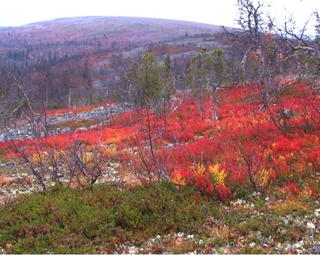 Syyskuun lopussa Värriötunturin maaruska on täydessä loistossaan. Punainen massaväri tulee mustikasta. Riekonmarjan karmiiniväri alkaa jo hiipua. Koivut ovat jo lehdettömiä.
Syyskuun lopussa Värriötunturin maaruska on täydessä loistossaan. Punainen massaväri tulee mustikasta. Riekonmarjan karmiiniväri alkaa jo hiipua. Koivut ovat jo lehdettömiä.In the end of September the autumn colors of the ground are in theis peak. The massive red comes from bilberry (Vaccinium myrtillus), whereas the carmine red of alpine bearberry (Arctostaphylos alpinus) arealready fading out. The leaves of birches have fallen down.
Thursday, September 29, 2005
Kolme isokoskeloa Kuutsjärvessä - Three Goosangers in Kuutsjarvi
Kolme isokoskeloa (Mergus merganser) laskeutui, ilmeisesti muuttomatkallaan Kuutsjärveen. Lieneekö isokoskeloilla ollut aavistus Kuutsjärveen jo 1980-luvulla istutetuista taimenista. Niiden kanta on kasvanut suureksi niin, että taimenten keskikoko jää pieneksi, juuri sopivan kokoisiksi isokoskelon saalistaa.
Isokoskelo on harvinainen vieras pienikokoisessa, kaltiolammen tyyppisessä, kurussa sijaitsevassa Kuutsjärvessä.
Three Goosangers (Mergus merganser) landed in Kuutsjarvi lake below the Varrio station. They were apparently already on their migrating travel. Perhaps Goosangers had a hint about the small trouts in the lake, which are the outcome of an early planting in 1980s. The trout population is overcrowded and thus their size is rather small - just suitable for Goosanger to fish.
Goosanger is a rare visitor in small Kuutsjarvi lake.
Isokoskelo on harvinainen vieras pienikokoisessa, kaltiolammen tyyppisessä, kurussa sijaitsevassa Kuutsjärvessä.
Three Goosangers (Mergus merganser) landed in Kuutsjarvi lake below the Varrio station. They were apparently already on their migrating travel. Perhaps Goosangers had a hint about the small trouts in the lake, which are the outcome of an early planting in 1980s. The trout population is overcrowded and thus their size is rather small - just suitable for Goosanger to fish.
Goosanger is a rare visitor in small Kuutsjarvi lake.
Labels: isokoskelo
Wednesday, September 28, 2005
Sokli; koivua ja katajaa - Birch and juniper growing in mixture in Sokli
 Soklin kaivosalue sijaitsee Värriön luonnonpuiston luoteispuolella. Tasainen männikkö muuttuu siellä yhtäkkiä merkilliseksi kaksijaksoiseksi metsäksi. Alempi kerros on katajaa ja ylempi kerros koivua. Selityksenä pidetään fosforipitoista maaperää. Siksi Sokliin suunniteltiin fosforikaivosta 1960- ja 1970-lukujen vaihteessa, aikana jolloin fosforipitoisten metsälannoitteiden tuleva menekki näytti aina vain kasvavalta. Metsälannoitus uupui Suomessa kuitenkin 1970-luvun energiakriiseihin, eikä Soklin fosforikaivosta koskaan avattu.
Soklin kaivosalue sijaitsee Värriön luonnonpuiston luoteispuolella. Tasainen männikkö muuttuu siellä yhtäkkiä merkilliseksi kaksijaksoiseksi metsäksi. Alempi kerros on katajaa ja ylempi kerros koivua. Selityksenä pidetään fosforipitoista maaperää. Siksi Sokliin suunniteltiin fosforikaivosta 1960- ja 1970-lukujen vaihteessa, aikana jolloin fosforipitoisten metsälannoitteiden tuleva menekki näytti aina vain kasvavalta. Metsälannoitus uupui Suomessa kuitenkin 1970-luvun energiakriiseihin, eikä Soklin fosforikaivosta koskaan avattu.Sokli phosphorite area is situated north-west of Varrio nature reserve. In Sokli the Scots pine forest suddenly changes into strange two-layer forest: the upper layer is pure birch (Betula pubescens) and the lower layer is growing dense juniper (Juniper communis). The explanation for this is thought to be the phosprorus-rich soil of Sokli. That is why a phosphorite mine was planned to be opened in Sokli at the turne of 1960s to 1970s. This was the time when forest fertilization (which needed a lot of phosphorus) was in a steady rise in Finland. The forest fertilization, however, went drastically down after the 1970s energy crises. As a result, Sokli mine was never opened.
Tuesday, September 27, 2005
Kuntasjoki odottaa talvea - Kuntas river waits for the winter
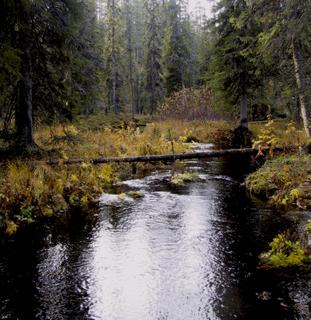 Myös Kuntasjoen kurun rehevä kasvillisuus on jo lakastunut. Syksyn sateet ovat lisänneet veden virtaamaa joessa.
Myös Kuntasjoen kurun rehevä kasvillisuus on jo lakastunut. Syksyn sateet ovat lisänneet veden virtaamaa joessa.Also the lush vegetation of Kuntas creek has withered. The autumn rains have raised the water flow in the river.
Monday, September 26, 2005
Syysmyrskyt kaatavat vanhoja kuusia - Autumn storms fell old spruces
Sunday, September 25, 2005
Kukkiko Lapissa kaikki nopeammin, osa 5 rentukka - Did Caltha palustris flower earlier ?
Saturday, September 24, 2005
Kukkiko Lapissa kaikki nopeammin, osa 4, tuomi - Did Prunus padus flower quicker?
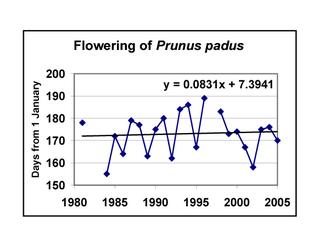
Kukkiiko Värriön tuomi nykyään nopeammin kuin parikymmentä vuotta sitten? Ei. Vuonna 1981 tuomen kukinta alkoi tasolla 21. kesäkuuta. Vuonna 2005 tuomen kukinta alkoi keskimäärin kaksi päivää myöhemmin. Jälleen hajonta noususuoran molemmin puolin on niin suuri, että nousulla ei ole tilastotieteellistä merkitsevyyttä. - Vuonna 2006 tuomen kukinnan voi ennustaa alkavan 23. kesäkuuta.
Does Prunus padus flower in Varrio nature reserve now earlier than some 20 years ago, as the climate change might let understand? No, it does not flower earlier. In 1981 the onset of flowewring happened on 21 June. In 2005 the onset started, not earlier but two days later. Again the variation around the trend line is so big that the rising trend in the graph is not statistically significant. - The predicted flowering of Prunus padus in 2006 should hanve its onset on 23 June.
Friday, September 23, 2005
Kukkiko Lapissa kaikki nopeammin, osa 3, hilla - Did Cloudberry flower earlier?
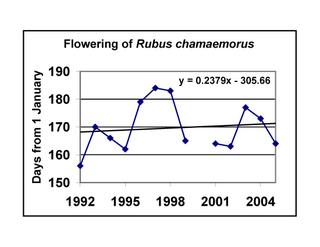
Kukkiko Lapissa kaikki nopeammin, osa 3 (katso luontopäiväkirjan mustikan kukintakuva 5.7.2005, ja puolukan kukintakuva 13.8.2005).
Hillan (Rubus chamaemorus) kukintaa on seurattu tarkasti Värriön tutkimusasemalla vuodesta 1992. Hillan kukinnan alku näyttää myöhästyneen kuluneen 14 vuodena aikan hieman, 4 päivällä. Vuosivaihtelu on jälleen niin suuri, että myöhästymisellä ei ole tilastotieteellistä merkitystä. - Ennuste seuraavalle Värriön hillan kukinnan alkamiselle on 21.6.2006.
Flowering of cloudberry (Rubus chamaemorus) has been followed in Varrio nature reserve since 1992. During the past 14 years the onset of flowering seems to have been delayed a little, by 4 days. The annual variation is, however, so big that the phenomenon does not have statistical significance. - The predicted flowering in 2006 of Cloudberry starts on 21 June.
Thursday, September 22, 2005
Räkättirastaiden outo muuttosuunta - Strange flying direction of Fieldfares
Värriön tutkimusaseman yli on lentänyt syyskuun aikana useita pienparvia räkättirastaita (Turdus pilaris), joiden lentosuunta on kaakosta luoteeseen. Näin oli myös syksyllä 2004. Mistä ne tulevat? Venäjän puolelta? Minne ne menevät? Luoteis-Norjan rannikolle?
Small groups of Fieldfares (Turdus pilaris) have flown in September over the Varrio research station, with the flying direction from southeast to northwest. This was oberserved in 2004, too. Where do they come from? from Russia? Where do they go to? To northwest coast of Norway?
Small groups of Fieldfares (Turdus pilaris) have flown in September over the Varrio research station, with the flying direction from southeast to northwest. This was oberserved in 2004, too. Where do they come from? from Russia? Where do they go to? To northwest coast of Norway?
Wednesday, September 21, 2005
Koska koivu hiirenkorvalla - When do we have the bud burst of birches in spring ?

Hieskoivulla ja sen alalajilla tunturikoivulla on Värriössä parhaillaan ruskan huippu, tai se on juuri ohitettu. Nyt jo kiinnostaa seuraava kevät: koska koivu on taas hiirenkorvalla?
Värriön fenologiatutkimuksessa on seurattu vuodesta 1981 tukikohdan ympäristön koivujen puhkeamista hiirenkorvalle. Se tapahtuu nyt keskimäärin 4. kesäkuuta. Tämä päivä on ennuste myös vuodelle 2006.
Ajankohta on hieman aikaistunut vuodesta 1981. Silloin Värriön tutkimusaseman koivut tulivat hiirenkorvalle 8. kesäkuuta. -Vuosien välinen vaihtelu on suuri, eikä hiirenkorvan ajankohdan aikaistuminen ole tilastotieteellisesti merkitsevä.
The autumn colour change of Lapland birches (mainly of Betula pubescens) is in its peak in Varrio, or has already passed it. Already now people start to guess when do we have the bud burst of Betula in next spring.
The phenology research of Varrio has followed the bud burst of birches at constant spot in the station since 1981. The bud burst takes place nowadays on average on 4 June. This date is also the prognosis for the spring 2006.
The date for bud burst has become a little earlier since 1981. Then the bud burst happened four days later, on average on 8 June. - It must however, be noticesd that the variation between the years is considerable, and the earlier trend has no statistical significance.
Tuesday, September 20, 2005
Guttaatiovettä juolukassa - Guttation water in Bog bilberry?
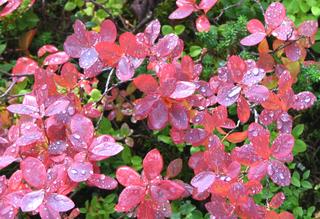 Ensi lumi on Värriöstä sulanut. Lumettomassa, mutta syksyisen sateisessa maastossa vaeltava törmää taas tuttuun ilmiöön. Kaikista marjoista ja varvuista eniten maastokenkiä kastelee juolukka (Vaccinium uliginosum, vrt latinan sana uligo - kosteus). Tuulisina aamuinakin juolukka pisaroi vettä vielä silloin, kun mustikan varvikko on jo kuiva. Onko kyseessä juolukan lehden erikoinen, vettä keräävä ulkoinen rakenne. Vai onko kyseessä guttaatiovesi, jota eräät kasvit työntävät juuripaineella erityisten huokosten kautta?
Ensi lumi on Värriöstä sulanut. Lumettomassa, mutta syksyisen sateisessa maastossa vaeltava törmää taas tuttuun ilmiöön. Kaikista marjoista ja varvuista eniten maastokenkiä kastelee juolukka (Vaccinium uliginosum, vrt latinan sana uligo - kosteus). Tuulisina aamuinakin juolukka pisaroi vettä vielä silloin, kun mustikan varvikko on jo kuiva. Onko kyseessä juolukan lehden erikoinen, vettä keräävä ulkoinen rakenne. Vai onko kyseessä guttaatiovesi, jota eräät kasvit työntävät juuripaineella erityisten huokosten kautta?The first snow has disappeared from Varrio fells. Wandered of the snow free but moist autumn forest, faces again an interesting phenomenon. Of all the herbs and berries Bog bilberry (Vaccinium uliginosum) keeps wet most of the day, even if other herbs like Bilberry dry up easily. Refer the Latin word uligo - moistness. Does Bog bilberry have a special outer structure in the leaves? Or is the phenomenon guttation, secretion of water on to the surface of leaves through specialized pores, called hydathodes?
Monday, September 19, 2005
Riekonmarjaa parhaiten Värriö III:lla - Alpine bearberry yield best in Varrio III

Riekonmarja (Arctostaphylos alpinus) muuttuu kypsyessään punaisesta mustaksi; sen lehdet muuttuvasta samalla vihreistä karmiininpunaisiksi (katso luontopäiväkirjan kuva 4.8.2005). Riekonmarjan sato on laikuttainen. Se marjoo ylipäänsä paremmin Lapin avotunturissa kuin Lapin metsäisissä vaaroissa. Avotuntureissakin sen sato vaihtelee huipulta toiselle. Syksyllä 2005 riekonmarjaa löytyi - marjovana - parhaiten Värriö III:n kaakkoisrinteeltä.
Alpine bearberry (Arctostaphylos alpinus) turns from read to black while ripening; simultaneously its leaves turn from green to carmine red (see the Nature diary photo of 4 August 2005). The Alpine bearberry yield is patchy. All in all, its berries is easier to find in open fell tops than in forested hill sites, even if the foliar growth may be abundant. But also in open fell tops the Alpine bearberry yield varies from top to top. In the autumn 2005 the best yield of Alpine bearberry in Varrio reserve was found in the south-eastern slope of Varrio III fell.
Sunday, September 18, 2005
Värriön kasvukausi pidentynyt - Varrio growing season prolonged
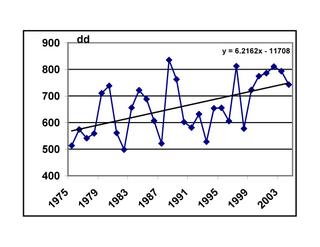
Kasvukauden pituutta on mitattu Värriössä vuodesta 1975 lähtien ns. astepäivämenetelmällä (engl. degree days, dd), jota myös tehoisan lämpötilan summan menetelmäksi kutsutaan. Lämpöä summaava ajattelu on kuitenkin käsitteenä harhaanjohtavaa, koska astepäivämenetelmässä on kyseessä kasvien aistiman biologisen ajan mittari. Se soveltuu verraten hyvin juuri subarktisen vyöhykkeen kasveille.
Astepäivämenetelmän kynnys on päivä, jolloin keskilämpötila on plus viisi astetta. Kun keskilämpötila on +5 C tai sen alle, astepäivät eivät kerry. Keskilämpötilan päivänä + 6 astetta kertyy yksi astepäivä, keskilämpötilan päivänä + 7 C kertyy kaksi astepäivää, keskilämpötilan +8 C päivänä kertyy kolme astepäivää ja niin edelleen.
Vuoden 1975 tasolla Värriössä kertyi astepäiviä keskimäärin 569 kappaletta. Keskilämpötilan noustua (vrt. luontopäiväkirjan merkintä 10.8.2005) myös kasvukauden astepäivien lukumäärä on noussut. Vuoden 2004 tasolla astepäiviä oli jo 749 kappaletta. Näin astepäivien lukumäärä on noussut kahdenkymmenenviiden vuoden kuluessa 180:lla. Toisin sanoen: Värriön kasvien kannalta pidentyneeseen kasvukauteen on tullut +6 asteen päiviä lisää 180 kappaletta.
Kasvukauden pituudessa on keskimääräistä nousua 32 prosenttia. - Nousu on ilmeinen, mutta vuosivaihtelu on niin suuri, että nousulla ei ole (vielä) tilastotieteellistä merkitsevyyttä.
The length of the growing season has been measured since 1975 in Varrio using the degree day (dd) method. It is also called as method of effective heat (or temperature) sum. The degree day method is an approximation of biological clock, which is rather well suited to the plansts of subarctic areas. The threshold value in degree day method is the day of an average temperature of 5 degrees (Celcius). On such or colder days the degree day units do not accumulate. On a day of average temperature of 6 degrees one degree day accumulates, on a day of +7 C two degree days accumulate, on a day of +8 C three degree days accumulate and so on.
At 1975 level on average 569 degree days accumulated. While the average temperature has risen in Varrio (see Nature diary graph of 10 August 2005) also the number of degree days has risen. At 2004 level already 749 degree days accumulated. During the past 25 years the degree days have increased by 180. In other words: the plants of Varrio have reacted like there were in 2004 altogether 180 days more of +6 degrees, than there used to be in 1975.
The length of the growing season has increased by 32 per cent. - The increasing trend is evident, but the the variation around the trend line is still so big that the phenomenon does not have statistical significance.
Saturday, September 17, 2005
Puustotietoja Värriön luonnonpuistosta - Basic forest facts on Varrio reserve
 Vuoden 1990 metsälaskennan mukaan Värriön luonnonpuiston 9,500 hehtaarin metsämaasta (poislukien tunturipaljakat ja suot) kasvaa pääosaksi mäntyä. Sen osuus on 57 prosenttia, ja keskikuutio 48 m3/ha. Kuusen osuus 33 prosenttia ja keskikuutio 28 m3/ha. Koivun osuus on 10 prosenttia ja keskikuutio 9 m3/ha. Koko 9,500 hehtaarin metsäisellä alueella puuston yhteinen keskikuutio on 85 m3/ha ja kokonaispuusto 0,77 miljoonaa kuutiometriä. - Kuva outamaalta Kuntaskurun pohjoispuolelta.
Vuoden 1990 metsälaskennan mukaan Värriön luonnonpuiston 9,500 hehtaarin metsämaasta (poislukien tunturipaljakat ja suot) kasvaa pääosaksi mäntyä. Sen osuus on 57 prosenttia, ja keskikuutio 48 m3/ha. Kuusen osuus 33 prosenttia ja keskikuutio 28 m3/ha. Koivun osuus on 10 prosenttia ja keskikuutio 9 m3/ha. Koko 9,500 hehtaarin metsäisellä alueella puuston yhteinen keskikuutio on 85 m3/ha ja kokonaispuusto 0,77 miljoonaa kuutiometriä. - Kuva outamaalta Kuntaskurun pohjoispuolelta.According to the forest inventory of 1990 Varrio nature reserve, by its forest dominated area of 9,500 hectares grows mainly Scots pine. Its share is 57 per cent and the mean volume 48 m3/ha. The share of Norway spruce is 33 per cent with mean volume of 28 m3/ha. The share of pubescent birch is only 10 per cent with mean volume of 9 m3/ha. The overall forested area of 9,500 ha has the total mean volume of 85 m3/ha. Thus the estimated wood volume in Varrio nature reserve is 0.77 million cubic meters. - The photograph has been taken in old Scots pine dominated forest, north of Kuntas creek.
Friday, September 16, 2005
Pinta-alatietoja Värriön luonnonpuiston metsistä - Basic areal facts on Varrio forests
 Värriön luonnonpuiston metsälaskenta on tehty ilmakuvien perusteella viimeksi vuonna 1990. Puiston kokonaispinta-alalta 12,500 hehtaaria. Siitä on kasvullista metsämaata (puuston kasvu yli 1 m3/ha/v) kolmannes eli 4,300 hehtaaria. Kitumaata (puuston kasvu 0.1-1.0 m3/ha/v) on 38 prosenttia eli 4,700 hehtaaria. Loppu on metsätaloudellisessa mielessä joutomaaksi (puuston kasvu alle 0.1 m3/ha/v) luokiteltuja tunturipaljakoita ja soita, 28 prosenttia eli 3,500 hehtaaria. - Kuva Pulkkatunturista Värriötunturien suuntaan.
Värriön luonnonpuiston metsälaskenta on tehty ilmakuvien perusteella viimeksi vuonna 1990. Puiston kokonaispinta-alalta 12,500 hehtaaria. Siitä on kasvullista metsämaata (puuston kasvu yli 1 m3/ha/v) kolmannes eli 4,300 hehtaaria. Kitumaata (puuston kasvu 0.1-1.0 m3/ha/v) on 38 prosenttia eli 4,700 hehtaaria. Loppu on metsätaloudellisessa mielessä joutomaaksi (puuston kasvu alle 0.1 m3/ha/v) luokiteltuja tunturipaljakoita ja soita, 28 prosenttia eli 3,500 hehtaaria. - Kuva Pulkkatunturista Värriötunturien suuntaan.Ordinary forest inventory over Varrio nature reserve was done last time in 1990. The total area of the reserve is 12,500 hectares. One third (4,300 ha) was classified as forest land proper (where the annual growth is more than one m3/ha/a). Slow growing forest (annual growth between 0.1-1.0 m3/ha/a) covers 38 per cent or 4,700 ha. The remaining 28 per cent or 3,500 ha has been classified as waste land in forestry terms, where the annual timber growth is less than 0.1 m3/ha/a. It consists mainly of fell and hill tops and of open peatlands. - The photograph has been taken from Pulkkatunturi fell towards Varrio I.
Thursday, September 15, 2005
Milloin lumipeite häviää 2006 - When does the winter snow disappear in spring 2006?
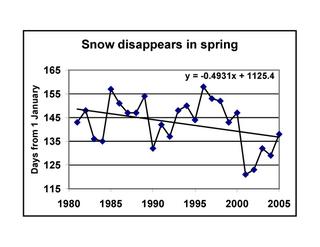
Värriössä on jo satanut ensilumen. Lumipeite on tuskin vielä pysyvä. Mutta kun pysyvä lumi tulee, Lapin ihmistä askarruttava kysymys jo on: Milloin lumi mahtaa sulaa seuraavana keväänä?
Pysyvän lumipeitteen häviämistä on seurattu Värriön tutkimusaseman säähavaintoasemalla vuodesta 1981. Kuluneen 25 vuoden aikana lumipeitteen sulaminen on aikaistunut keskimäärin 12 päivällä, kalenteripäivästä 149 kalenteripäivään 137. Vuosivaihtelu on tässäkin tapauksessa (vrt. puolukkakuva 13.9.2005) niin suurta, että ilmiölle ei ole (vielä) tilastotieteellistä merkitsevyyttä. Havaintojen perusteella voi kuitenkin ennustaa, että vuonna 2006 lumipeite häviää kalenteripäivänä 136, mikä on 16. toukokuuta.
First snow has come to Varrio fells. This snow hardly stays over the winter. However, there is already now a puzzling question in the minds of Lappish people: When does the snow of winter 2005/2006 finally disappear in spring? The disappearance of snow has been followed in Varrio since 1981. During the past 25 years the snow disappearance has become earlier on average by 12 days, from calendar day 149 to calndar day 137. The annual variation around the trend line is, again (see Cowberry graph of 13 Sep 2005) so large that the trend is not statistically significant. Based on the observations we can predict that in spring 2006 the snow disappears on calendar day 136, which is 16th of May.
Wednesday, September 14, 2005
Värriössä ensilumi - First snow in Varrio
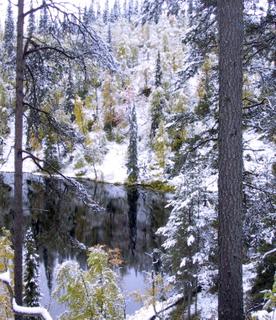 Värriössä satoi ensilumen 12.9.-13.9.2005 välisenä yönä. Lumi suli päivällä pois, mutta aamulla 14.9.2005 maa oli taas valkeana. Ensilumen ajankohta on normaali, ja esimerkiksi vuonna 2004 ensilumi tuli 15.9.-16.9. välisenä yönä. Värriön korkeus vedenjakanaseutuna korostuu ensilumen aikoina.
Värriössä satoi ensilumen 12.9.-13.9.2005 välisenä yönä. Lumi suli päivällä pois, mutta aamulla 14.9.2005 maa oli taas valkeana. Ensilumen ajankohta on normaali, ja esimerkiksi vuonna 2004 ensilumi tuli 15.9.-16.9. välisenä yönä. Värriön korkeus vedenjakanaseutuna korostuu ensilumen aikoina.The first snow in the autumn 2005 came in the night between 12.-13. September. The snow melted during the day, but in the morning of 14th September the ground was white again. The season for first snow is normal; for instance in 2004 the first snow came in the night between 15.-16. September. The relatively high altitude of Varrio partly explains why the first snow can be seen there earlier than other (lower) parts of eastern Lapland.
Tuesday, September 13, 2005
Puolukasta hyvä sato - Cowberry yield good all over Lapland
 Puolukasta (Vaccinium vitis-idae) saadaan vuonna 2005 koko Lapissa ja Pohjois-Suomessa hyvä sato. Värriön leveysasteella puolukan poiminnan huippu on syyskuun puolivälissä.
Puolukasta (Vaccinium vitis-idae) saadaan vuonna 2005 koko Lapissa ja Pohjois-Suomessa hyvä sato. Värriön leveysasteella puolukan poiminnan huippu on syyskuun puolivälissä.Cowberry (Vaccinium vitis-idae) yield has been good in 2005 all over Lapland and Northern Finland. The peak of the picking season in Varrio latitude is in the middle of September.
Puolukan kukintarytmissä ei muutoksia - The pattern of flowering with Cowberry does not show any change
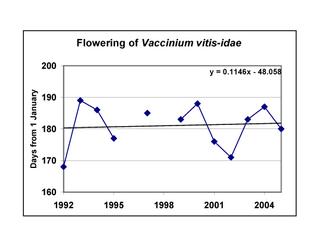
Puolukkaa poimitaan Itä-Lapissa parhaillaan. Puolukka on yksi Värriön tutkimusaseman seurantakasveja. Puolukan kukinnan alkaminen on kirjattu samassa kasvustossa vuodesta 1992. Puolukka kukkii Värriön marjoista viimeisenä, keskimäärin 1. heinäkuuta. Se on 182. kalenteripäivä vuoden alusta.
Puolukan kukinta näyttää myöhästyneen 13 vuodessa keskimäärin yhdellä päivällä (päivästä 181 päivään 182). Vuosien välinen vaihtelu on kuitenkin niin suurta, että yhden päivän heitto mahtuu tilastollisen virhemahdollisuuden rajaan.
Picking of Cowberry (Vaccinium vitis-idae) is approaching its peak in Eastern Lapland. Cowberry is one of phenological indicator plants in Varrio. The onset of Cowberry flowering has been recorded in constantfield spot since 1992. Cowberry flowers as last of all the Varrio berries; the onset is on average on 1 July. The respective calendar day is number 182 from the beginning of the year.
The onset of Cowberry flowering seems now to take place on average one day later than in 1992 (change from day 181 to day 182). The variation between the years, however, is so big that this possible delay has no statistical significance.
Monday, September 12, 2005
Ruskaa Puolivälinjängällä - Puolivalinjanka mire changes color
 Ruska värjäsi myös Puolivälinjängän. Kuva pitkospuilta kohti tukikohtaa. Kellertävä väri taustalla tulee pullosarasta (Carex rostrata - "kenkäheinä"). Ruskea väri etualalla tulee vaivaiskoivusta (Betula nana).
Ruska värjäsi myös Puolivälinjängän. Kuva pitkospuilta kohti tukikohtaa. Kellertävä väri taustalla tulee pullosarasta (Carex rostrata - "kenkäheinä"). Ruskea väri etualalla tulee vaivaiskoivusta (Betula nana).The autumn colors have taken over the Puolivalinjanka aapa mire as well. Track in the photo is leading towards Varrio station. The yellowish color behind comes from Bottle sedge (Carex rostrata - "Shoe grass"). The brownish color in front comes from Dwarf birch (Betula nana).
Sunday, September 11, 2005
Ensimmäinen hallayö Värriössä - First night frost in Varrio
Värriön tutkimusaseman automaattinen lämpötila-anturi mittasi ensimmäisen syyshallan lauantain ja sunnuntain (11.9.2005) välisenä yönä. Lämpötila laski klo 04:00 lukemaan -1,2 astetta 2 metrin korkeudella. Maanpinnassa minimilämpötilan mittari näytti -3.0 astetta. Tänä vuonna ensimmäinen syksyn yöhalla tuli poikkeuksellisen myöhään.
Erään näkökannan mukaan syksyn hallayöt käynnistävät ruskan. Värriötunturissa sekä puu- että maaruska ovat alkaneet jo päiviä sitten ja ne olivat lauantaina 10.9.2005 lähes täydessä huipussaan - ilman seuraavan yön ensihallaakin.
The automatic temperature sensor of Varrio climate station recorded the first autumn night frost in the night between Saturday and Sunday (11 Sep 2005). At the recording height of 2 meters the temperature dropped down to -1.2 degrees at 04:00 in the morning. The minimum tempereture meter at ground level showed -3.0 degrees. This year the first night frost came exceptionally late.
According to an old belief the change of Lapland autumn colors is triggered by the first night frosts. This year the yellowish and reddish colors in the trees and herbs have been visible already for about 10 days. Varrio fells were near to the peak of "ruska", the symphony of brigt autumn colors already on Saturday 10 September - even without the coming first frost in the following night.
Erään näkökannan mukaan syksyn hallayöt käynnistävät ruskan. Värriötunturissa sekä puu- että maaruska ovat alkaneet jo päiviä sitten ja ne olivat lauantaina 10.9.2005 lähes täydessä huipussaan - ilman seuraavan yön ensihallaakin.
The automatic temperature sensor of Varrio climate station recorded the first autumn night frost in the night between Saturday and Sunday (11 Sep 2005). At the recording height of 2 meters the temperature dropped down to -1.2 degrees at 04:00 in the morning. The minimum tempereture meter at ground level showed -3.0 degrees. This year the first night frost came exceptionally late.
According to an old belief the change of Lapland autumn colors is triggered by the first night frosts. This year the yellowish and reddish colors in the trees and herbs have been visible already for about 10 days. Varrio fells were near to the peak of "ruska", the symphony of brigt autumn colors already on Saturday 10 September - even without the coming first frost in the following night.
Saturday, September 10, 2005
Sauoiva ruskan takana - Sauoiva fell behind autumn colors

Syyskuun 10. päivänä Värriötuntureiden ruska on lähes huipussaan. Koivikot kirjaavat maiseman Värriö II:lta Sauoivalle. Laakson havupuuvaltaisuus erottuu nyt hyvin. Sauoivasta (615 m) oikealle erottuu Peuratunturin huippu (530 m).
On 10 September the change of autumn colors is near to its peak in Varrio fells. The birch trees shine as yellow in the forest scenery. The dominance of conifers is now well seen. Sauoiva fell (615 m) is the highest peak in Varrio nature reserve. In the distance, right from Sauoiva, the peak (530 m) of Peuratunturi fell, is seen.
Syväkuru ruskassa - Deep creek in autumn colors
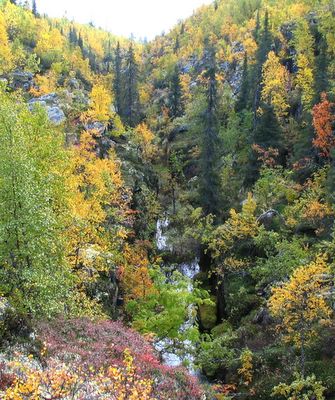
Värriötunturin huippujen kaksi ja kolme välistä alkaa itään viettävä, kasvi- ja lintumaailmaltaan rikas Syväkuru. Sen ylittäminen - kohtuullisen helposti - onnistuu vain länsipuolelta, kurun satulasta. Hirvasjoen lähteet (kuvassa) ovat tämän satulan alapuolella.
Deep creek, rich in its flora and bird fauna, starts between the Varrio fells 2 and 3. Crossing Deep creek is possible only - with moderate effort - in its western end, in the saddle between the two fells. The sources of Hirvasjoki river (in the photograph) are below this saddle.
Friday, September 09, 2005
Ryssänpäitä kesäpolulla - Common sedge at Varrio track

Värriön kesäpolun varressa, tutkimusasemaa lähimmällä olevalla pitkospuuosuudella, Varrio I:n pohjoispuolella, kasvaa loppukesästä kuivahtavassa rommakossa joukko tuuheita mättäitä. Kyseessä on tupassara (Carex nigra var. juncea). Kansan keskuudessa mättäitä kutsutaan "ryssänpäiksi".
At the foothill of Varriofell (Varrio I), just northside of Varrio track, there is a small pond which dries up at the end of the summer. A group of Common sedges, in Lapland the variety Carex nigra var. juncea, grows in the spot. Local people have given nickname to these sedge tufts: "Russian's head".
Thursday, September 08, 2005
Juolukkaa violetissa - Bog bilberry in violet

Juolukka (Vaccinium uliginosum) antaa Värriötunturin ruskaan oman violetin värisävynsä. Juolukka marjoo Värriössä heikosti - muutamat kuvassa näkyvät marjat ovat variksenmarjoja (Empetrum nigrum).
Bog bilberry (Vaccinium uliginosum) gives a violet tone in the autumn colors of Varrio fells. Bog bilberry yields poorly in Varrio - few black berries in the picture are those of Crowberry (Empetrum nigrum)
Wednesday, September 07, 2005
Ruskaa tihkusateessa - Autumn colors in misty rain

Tihkusateisena syyskuun päivänäkin ruska etenee Värriö I:n pohjoisrinteessä Kuutsjärven takana. Hieskoivujen geneettiset erot näkyvät tässä vaiheessa selvästi. Yksinäinen pihlaja loistaa punaisena kynttiläkuusien seassa.
On misty and rainy early September day the development of autumn colors continues despite of constant temperature (about 10 degrees). Genetical differences of the pubescent birches are well visible at this stage. A lonesome rowan (Sorbus aucuparia) shines as red amidst of candle-like Norway spruces.
Tuesday, September 06, 2005
Loikkarimetso palasi Suomeen - Capercaillie came back to Finland
Radiopantametso numero 67 vietti kesän Venäjällä ilman passia ja viisumia. Metso67 tavattiin nyt ensimmäistä kertaa sitten toukokuun Suomen puolella, Pulkkatunturin länsirinteellä.
Capercaillie (Tetrao urogallus) with radio transmitter spent all summer in Russia without passport and visa. Capercaillie number 67 was found in Finland first time since May from western hillside of Pulkkatunturi fell. (PM)
Capercaillie (Tetrao urogallus) with radio transmitter spent all summer in Russia without passport and visa. Capercaillie number 67 was found in Finland first time since May from western hillside of Pulkkatunturi fell. (PM)
Leutoja syysöitä Värriössä - Warm autumn nights in Varrio
 Suuressa osassa Lappia maa on ollut jo kuurassa hallayön jäljiltä. Värriön tutkimusasema sijaitsee Kotovaaran rinteellä 365 metriä merenpinnan yläpuolella ja on välttänyt toistaiseksi alavien maiden hallat. Kahtena viime yönä alin lämpötila on ollut +1 celsiusastetta. Syksyn värit hehkuvat haavan lehdissä vaikkei pakkanen ole niitä puraissutkaan.
Suuressa osassa Lappia maa on ollut jo kuurassa hallayön jäljiltä. Värriön tutkimusasema sijaitsee Kotovaaran rinteellä 365 metriä merenpinnan yläpuolella ja on välttänyt toistaiseksi alavien maiden hallat. Kahtena viime yönä alin lämpötila on ollut +1 celsiusastetta. Syksyn värit hehkuvat haavan lehdissä vaikkei pakkanen ole niitä puraissutkaan.Last nights have been very cold in most part of Lapland and minus degrees have been common. Varrio reseach station is situated 365 meter above sea level and here nights have been warmer than in lower areas. The lowest temperature of two last nights was +1 degree centigrade. Aspen (Populus tremula) does not need night frosts to get beautiful autumn colours. (PM)
photo: Ella-Maria Kyrö
Monday, September 05, 2005
Poronjäkälä syödään, tinajäkälä kasvaa - Reindeers eat Cladina species, Stereocaulon paschale grows
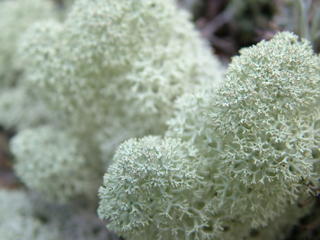 Palleroporonjäkälä (Cladina stellaris) on poron lempiruokaa. Värriössä muhkeimmat poronjäkäläpatjat löytyvät louhikkoisista kuruista, missä porot eivät liiku.
Palleroporonjäkälä (Cladina stellaris) on poron lempiruokaa. Värriössä muhkeimmat poronjäkäläpatjat löytyvät louhikkoisista kuruista, missä porot eivät liiku.Reindeer-lichens (Cladina sp., photo Cladina stellaris) are reindeers favourite food. The thickest Cladina-vegetations in Varrio nature reserve grow on rocky bottoms of canyons, where reindeers seldom graze.

Röpelöistä uudenvuoden tinaa muistuttava tinajäkälä (Stereocaulon paschale) kasvaa yleisenä porojen laiduntamilla kankailla. Tämä pienikokoisempi jäkälä ei ole poroille yhtä mieluista ruokaa kuin porojäkälät, ja se onkin hyötynyt runsaasta laiduntamisesta.
Stereocaulon paschale is smaller than reindeer-lichens and not so palatable for reindeers. Stereocaulon paschale benefits from reindeers grazing. (PM)
photos: Ella-Maria Kyrö
Sunday, September 04, 2005
Kynttiläkuusi Värriö II:lla - Candle spruce in Varrio II

Kynttiläkuuset nousevat Värriötuntureiden välisissä kuruissa Regio subalpina -vyöhykkeeseen. Kuusien menestymistä rajoittava tekijä ei ole niinkään lämpötila tai maaperä vaan talvinen tykkylumi. Se murtaa oksia ja usein latvuksenkin. Tykyn painamana kuusi kasvattaa oksansa aina maan rajaan asti, kuten tässä Värriö II:n lounaisrinteellä kasvavassa yksilössä.
Norway spruces (Picea abies) grow like candles in Regio subalpina belt of Varrio fells. Low temperature as such is not the limiting factor for spruce survival, but the heavy snow that presses the branches and breaks tops. Under the snow burden the surviving spruces let their branches grow down to ground level - as is the case in this tree that is growing on the south-western slope of Varrio II.
Hiiripöllö kesäpolun pönttöalueella - Northern hawk owl at Varrio track
Melko pitkästä aikaa näin hiiripöllön kesäpolun pönttöalueella kelokuusen latvassa klo 11.40. TH
After a while I managed to see a Northern hawk owl (Surnia ulula) inside Varrio nature reserve. It sat on the dried top of a dead Norway spruce, at foothill of Varriofell (Varrio I), near to the summer track to the station. TH
After a while I managed to see a Northern hawk owl (Surnia ulula) inside Varrio nature reserve. It sat on the dried top of a dead Norway spruce, at foothill of Varriofell (Varrio I), near to the summer track to the station. TH
Saturday, September 03, 2005
Rinnesuo Varrio II:lla - Slopy peatbog in Varrio II

Varrio II:n länsirinteellä on rinnesuo, joka on Nuorttijoen monia alkulähteitä.
There is a slopy beat bog on western edge of Varrio II fell. This peatbog, and a number of similar sites belongs to the sources of Nuortti river
Friday, September 02, 2005
Ruskan alkua mustikassa - Bilberry shows way to autumn colors

Ruska tekee alkuaan Värriötuntureilla, vaikka syyskuun alkupäivien ilma on vielä aurinkoinen ja lähes helteinen. Tunturissa ei ole tietoakaan yöpakkasista. Tunturikoivikko on vielä vihreä, mutta mustikka näyttää jo tietä ruskalle.
Two first days of September have been sunny and warm in the Varrio fells. There has not been any night frost in the fells. Fell birches are still green, but bilberry (Vaccinium myrtillus) shows already way to the coming Lapland autumn color exhibition.
Thursday, September 01, 2005
Isolepinkäinen Värriö III:lla - Great grey shrike in Varrio III
Isolepinkäinen (Lanius excubitor) lennähti istumaan keloutuneeseen kuusenkäkkärään Värriö III:n pohjoisrinteellä. Toisesta nimestään - Lapinharakka - päätellen sen odottaisi näkevänsä Värriön luonnonpuistossa ja ylipäänsä Itä-Lapissa useamminkin. Maastoretkillä sen tapaa verraten harvoin. Isolepinkäinen pesii silti Värriön luonnonpuistossa; tutkimusaseman havaintokirjassa on merkintä kolmesta löydetystä isolepinkäisen pesästä.
Grey great shrike (Lanius excubitor) flew into the top of a dry Norway spruce on the northern slope of Varrio III. Grey great shrike has a Finnish nickname "Lapland magpie". Thus one would expect to see the bird now and then in Varrio and elsewhere in Eastern Lapland. In the field observations Grey great shrike is rare. It is resident of Varrio nature reserve, however, as the research station logboog has three markings of found Grey great shrike nests.
Grey great shrike (Lanius excubitor) flew into the top of a dry Norway spruce on the northern slope of Varrio III. Grey great shrike has a Finnish nickname "Lapland magpie". Thus one would expect to see the bird now and then in Varrio and elsewhere in Eastern Lapland. In the field observations Grey great shrike is rare. It is resident of Varrio nature reserve, however, as the research station logboog has three markings of found Grey great shrike nests.
Ampuhaukka Värriö III:lla - Merlin in Varrio III
Ampuhaukka (Falco columbarius) liiteli syysauringossa Värriö III:n itälaitaa ja istuutui kuvattavaksi tunturikoivuun. Verraten harvoin tavattava ampuhaukka on silti Värriön jalohaukoista yleisin. Pesäpoikasten ja emon äänihavaintojen perusteella se pesi kesällä 2005 Kuntaskurussa.
Merlin (Falco columbarius) flew in the autumn sun along the eastern edge of Varrio III and sat down in Mountain birch for photographing. Merlin is seen rather seldom but still it is the most common of the falcons (Faconidae) in Varrio nature reserve. Based on hearing observation (chicks and female) it had a nest in Kuntaskuru canyon in the summer 2005.
Merlin (Falco columbarius) flew in the autumn sun along the eastern edge of Varrio III and sat down in Mountain birch for photographing. Merlin is seen rather seldom but still it is the most common of the falcons (Faconidae) in Varrio nature reserve. Based on hearing observation (chicks and female) it had a nest in Kuntaskuru canyon in the summer 2005.
Riekonmarja ja sianpuolukka - Alpine and Common bearberry

Vaikka riekonmarja (vasemmalla) ja sianpuolukka ovat lähisukulaisia - ne kuuluvat molemmat sukuun Arctostaphylos - niiden eroavuus paljastuu heti ruskan alkuvaiheessa. Riekonmarja on kesävihanta, sen lehdet värjäytyvät karmiininpunaiseen ruskaan ja putoavat ennen talvea. Sianpuolukka taas on ainavihanta, ja sen lehdet säilyvät vihreinä talven yli hangen alla.
Although Alpine bearberry (left) and Common bearberry are near relatives - they both belong to genus Arctostahylos - they have a clear ecological difference which can be seen early in the autumn. Alpine bearberry leaves turn into carmine red, wither and fall before the winter, whereas the leaves of Common bearberry stay evergreen over the winter, under the snow.

